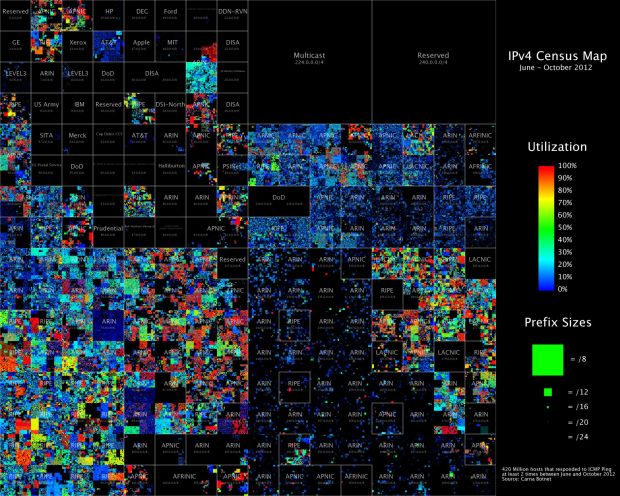Upon discovering hundreds of thousands open embedded devices on the Internet, an anonymous researcher conducted a Census of the Internet, mapping 460 million IP addresses around the world.
While playing around with the Nmap Scripting Engine (NSE) we discovered an amazing number of open embedded devices on the Internet. Many of them are based on Linux and allow login to standard BusyBox with empty or default credentials. We used these devices to build a distributed port scanner to scan all IPv4 addresses. These scans include service probes for the most common ports, ICMP ping, reverse DNS and SYN scans. We analyzed some of the data to get an estimation of the IP address usage.
It’s a pretty thorough analysis, but the conclusion interested me most:
The why is also simple: I did not want to ask myself for the rest of my life how much fun it could have been or if the infrastructure I imagined in my head would have worked as expected. I saw the chance to really work on an Internet scale, command hundred thousands of devices with a click of my mouse, portscan and map the whole Internet in a way nobody had done before, basically have fun with computers and the Internet in a way very few people ever will. I decided it would be worth my time.
It makes me feel…uneasy. [Thanks, Roger]



It’s not what you would call a representative sample. How can we know that the map of unhacked IP addresses does not provide a different picture ?
Just being huge does not guarantee the quality of a sample.
This was shown in the famous 1936 presidential poll when 10 million American voters were polled and 2.4 millions answered and predicted the wrong winner. The reason : the sampling was – unintentially – biased.
http://en.wikipedia.org/wiki/The_Literary_Digest
So big might be wrong.
What’s the case here ?
ftr – you misunderstand, the researcher used hacked devices to gather data, the survey itself is of all IP addresses, whether or not they were hacked. He merely used these open devices as a massive network to conduct research on a scale not typically possible by an individual. There are presumably still some sample biases but not of the scale you were thinking.